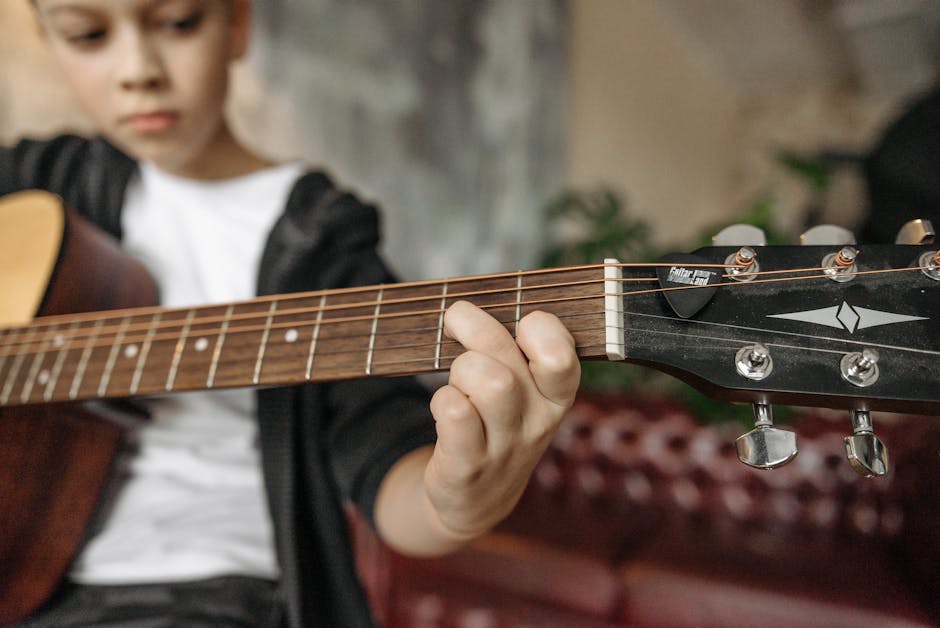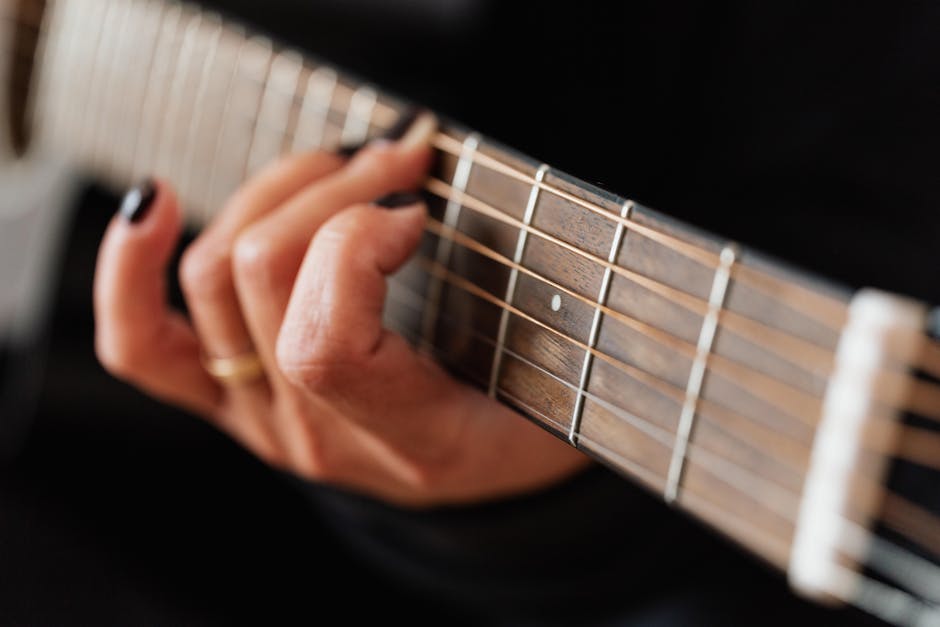Welcome to the mystical world of fingerstyle guitar, where nimble fingers dance across the strings like wizards casting spells. This ancient art form has long perplexed musicians and audiences alike with its enchanting melodies and mind-boggling intricacies. But fear not, dear reader, for today we embark on a journey to decode the secrets of fingerstyle guitar and unlock the magical powers of the humble six-stringed instrument. So grab your guitar, unleash your inner rockstar, and let’s dive into the wild and wonderful world of fingerstyle guitar!
Contents
- 1 Understanding the Foundations of Fingerstyle Guitar Technique
- 2 The Role of Right Hand Dynamics in Fingerstyle Mastery
- 3 Exploring Alternate Tunings for Creative Expression
- 4 Incorporating Percussive Elements to Elevate Your Playing
- 5 Navigating Complex Melodies with Finger Independence
- 6 The Art of Arranging Songs for Solo Fingerstyle Performance
- 7 Advanced Techniques: Harmonics, Tapping, and Slap Bass in Fingerstyle Guitar
- 8 FAQs
- 9 Strumming Through the Mysteries of Fingerstyle Guitar
Understanding the Foundations of Fingerstyle Guitar Technique
So you’ve decided to dive into the world of fingerstyle guitar playing, huh? Well, hold onto your picks because you’re in for a wild ride! Let’s break down the foundations of this finger-tapping, string-plucking, musical madness, shall we?
First things first, if you want to master fingerstyle guitar technique, you’ve got to get those fingers nimble and ready for action. Think of them as little acrobats, flipping and flopping their way across the fretboard. Start with some warm-up exercises to get those digits limbered up.
Next up, get familiar with the concept of finger independence. Each finger has its own role to play – kind of like a dysfunctional family where everyone has a specific job to do. Train them to work together, but also be prepared for the occasional rebellious middle finger that wants to go its own way.
Don’t forget about dynamics, my friend. This is where you can really make your playing come alive. Use those fingers to control the volume and intensity of each note. Think of it as a musical rollercoaster – sometimes you want to take it slow and steady, other times you want to whip those strings into a frenzy!
The Role of Right Hand Dynamics in Fingerstyle Mastery
When it comes to mastering fingerstyle guitar, one of the key elements that often gets overlooked is the role of right hand dynamics. Your right hand is like the conductor of an orchestra, determining the volume, tone, and overall feel of your playing. So, let’s dive into why right hand dynamics are so crucial in achieving fingerstyle mastery.
First and foremost, varying your right hand dynamics can add depth and emotion to your playing. Imagine playing a beautiful melody with all the notes at the same volume – it would sound like a robot reciting a grocery list. By incorporating dynamics, you can make your music come alive and truly connect with your audience.
Another reason why right hand dynamics are important is that they help you control the volume of individual notes. This is essential when playing complex passages with multiple notes ringing out simultaneously. By adjusting the dynamics of each note, you can ensure that your playing is clear and articulate.
Furthermore, mastering right hand dynamics can take your fingerstyle playing to the next level. By practicing techniques such as palm muting, fingerpicking, and using your nails, you can create a diverse range of tones and textures. So, don’t underestimate the power of your right hand – it’s the secret sauce to fingerstyle greatness!

Exploring Alternate Tunings for Creative Expression
Imagine a world where guitars are no longer limited to the standard EADGBE tuning. In this alternate universe, musicians have unlocked the power of alternate tunings to unleash their creativity in ways never thought possible. Think of alternate tunings as the key to unlocking a whole new level of musical expression – like finding a secret portal to a parallel dimension where the possibilities are endless.
With alternate tunings, you can transform your guitar into a mystical beast capable of producing unique and ethereal sounds that will transport your listeners to another realm. From the shimmering beauty of open C tuning to the dark and brooding depths of drop D, each alternate tuning offers its own sonic landscape for you to explore and conquer. Embrace the chaos and let your fingers dance across the fretboard in ways you never thought possible.
Dive deep into the world of alternate tunings and discover the hidden treasures that await you. Experiment with unconventional combinations of notes and chords to create a tapestry of sound that is truly your own. Let your imagination run wild as you navigate the uncharted waters of alternate tunings, fearless in the face of the unknown. Who knows what kind of magic you might uncover? So grab your guitar, tune up to something strange and wonderful, and let the musical journey begin.
Incorporating Percussive Elements to Elevate Your Playing
So you think you’ve got what it takes to be the next drumming sensation? Well, incorporating percussive elements into your playing is the key to taking your skills to the next level. It’s time to spice up your drumming routine and impress your audience with some killer beats that will make them want to get up and dance!
First things first, let’s talk about adding some flair to your drumming repertoire. Why stick to the same old boring beat when you can mix things up and add some unexpected percussive elements to your playing? Whether it’s using unconventional materials like pots and pans or incorporating body percussion into your routines, the sky’s the limit when it comes to creativity.
Looking to elevate your playing to rockstar status? Try experimenting with different rhythms and tempos to keep your audience on their toes. Whether it’s a funky disco beat or a fast-paced punk rock rhythm, don’t be afraid to step out of your comfort zone and try something new. Who knows, you might just discover a new signature style that sets you apart from the rest.
Remember, practice makes perfect, so don’t be afraid to put in the hours and experiment with different percussive elements. Show off your newfound drumming skills at your next gig and watch as the crowd goes wild. So grab your drumsticks, get ready to rock out, and let the percussive elements take your playing to new heights!

So, you’ve found yourself stuck in a labyrinth of complex melodies, struggling to maintain finger independence while navigating through the musical maze. Fear not! We have some tips and tricks to help you conquer this challenging journey.
First and foremost, **practice makes perfect**. Spend dedicated time each day working on exercises that focus on finger independence. This could include scales, arpeggios, or even specific melodic patterns that challenge your coordination.
Secondly, **break it down**. Don’t try to tackle the entire piece at once. Break it down into smaller sections and work on each part individually before putting it all together. This will help you focus on the specific finger movements required for each passage.
Another helpful tip is to **use visualization**. Close your eyes and imagine each finger moving independently of the others as you play. This mental exercise can help reinforce the physical movements required for finger independence.
The Art of Arranging Songs for Solo Fingerstyle Performance
So, you want to master , huh? Well, you’ve come to the right place! Get ready to take your guitar playing to the next level and wow your audience with your musical prowess.
First things first, choose a song that you absolutely love. This is crucial because you’ll be spending a lot of time with it, so make sure it’s a tune that really speaks to your soul. Once you’ve found the perfect song, it’s time to start breaking it down and figuring out how to arrange it for solo fingerstyle.
Next, experiment with different picking patterns and chord voicings to see what works best for the song. Don’t be afraid to get creative and try out new techniques – after all, this is your chance to showcase your unique style and musical flair. And remember, practice makes perfect, so don’t get discouraged if it takes some time to get the arrangement just right.
Lastly, when you’re ready to perform your newly arranged song, make sure to deliver it with confidence and flair. Connect with your audience, feel the music in your soul, and let your fingers do the talking. And most importantly, have fun with it – after all, music is meant to be enjoyed!
Advanced Techniques: Harmonics, Tapping, and Slap Bass in Fingerstyle Guitar
So you think you’ve mastered fingerstyle guitar, eh? Well, buckle up buttercup because we’re about to take things to a whole new level with some advanced techniques that will make your guitar scream like a banshee on a sugar high!
First up, we’ve got harmonics. Forget about strumming those boring old chords – it’s time to let your fingers dance delicately across the strings to create those sweet, ethereal harmonics that will make your audience weep with joy. Just lightly touch the strings at the 12th fret or above and watch as magic happens.
Next, let’s talk tapping. No, we’re not talking about tapping someone on the shoulder – we’re talking about tapping out sick licks on your guitar like a total rock god. Use your right hand to tap the strings while your left hand holds down notes to create a sound that will make Eddie Van Halen jealous.
And finally, slap bass. Who said slapping was just for bassists? Use your thumb to slap and pop the strings on your guitar like a funky ninja, adding a whole new dimension of rhythm and groove to your fingerstyle playing. Just make sure you don’t get too carried away – we don’t want any broken strings or shattered dreams!
FAQs
Why is fingerstyle guitar playing considered challenging?
Because you have to use multiple fingers on your picking hand at the same time, which can feel like juggling while riding a unicycle.
What are some essential techniques for mastering fingerstyle guitar?
Practice, practice, and more practice! Also, focus on developing independence and accuracy in each finger of your picking hand.
How can I improve my fingerstyle guitar speed?
Start slow and gradually increase your speed as you build muscle memory. Also, make sure your hand position is relaxed and efficient.
What are some popular fingerstyle guitar songs to learn?
Classics like “Blackbird” by The Beatles, “Tears in Heaven” by Eric Clapton, and “Dust in the Wind” by Kansas are great choices for beginners.
How can I add dynamics to my fingerstyle guitar playing?
Experiment with varying your picking strength, using techniques like palm muting, and incorporating techniques like hammer-ons and pull-offs.
What are the benefits of learning fingerstyle guitar?
Aside from impressing your friends and charming potential love interests, fingerstyle guitar playing can improve your dexterity, coordination, and overall musicianship.
Strumming Through the Mysteries of Fingerstyle Guitar
And there you have it, folks! By unraveling the enigma of fingerstyle guitar, we’ve unlocked a world of melodic magic and rhythmic wonder. So go forth, dear readers, and let your fingertips dance across those strings like never before. And remember, the true secret to mastering fingerstyle guitar? Practice, practice, and maybe a little bit more practice! Keep strumming, keep grooving, and who knows? Maybe one day you’ll be the next fingerstyle guitar virtuoso that everyone’s talking about. Rock on!



